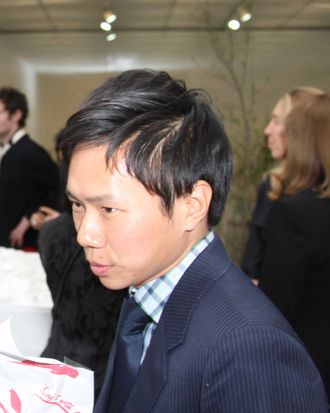
There was an intimate pre-party event last night at the Wright ÔÇö the Liam GillickÔÇôbedecked restaurant at the Solomon R. Guggenheim Museum ÔÇö during which select members of the media were given advance word on the winner of the 2014 Hugo Boss Prize. The catch? ÔÇ£The news of the winner is confidential for another 56 minutes,ÔÇØ explained Guggenheim director Richard Armstrong. None of the invited press were allowed to divulge the name of the honoree until the official announcement was made, as it would be nearly an hour later to┬áthe assembled crowd, including┬áKehinde Wiley,┬áEmma Sulkowicz, Margot Robbie, Kate Bosworth, and┬áNeville Wakefield, and other┬áexpensive-looking people milling around the central rotunda.
To the journalists in the restaurant, the candor seemed strangely obviated by the temporary vow of silence theyÔÇÖd imposed on their audience. What, precisely, was the point of telling anybody if they werenÔÇÖt supposed to tell anybody else? In fact, so long as they were at it, why bother telling anybody ever?
There was, after all, sufficient excitement even without the actual prize announcement, as art- and fashion-world grandees dashed in from the freezing cold and onto the crowded main floor of the museum. In an art market where corporate-sponsored biennials and fellowships and awards have proliferated at an alarming rate in the last decade, the Hugo Boss Prize is a┬ásilverback, having been┬ábestowed┬áevery other year┬ásince 1996 to artists such as┬áTacita Dean, Rirkrit Tiravanija, and Douglas Gordon.┬áItÔÇÖs a prize ÔÇö and a party ÔÇö worth showing up for, and its institutional parent isnÔÇÖt afraid to brag about it. ÔÇ£When we began the prize, we modeled it on the Turner Prize,ÔÇØ said Guggenheim deputy director and chief curator Nancy Spector, referring to the┬áone┬ágiven out┬áby BritainÔÇÖs Tate Gallery. (It might be worth noting that that one, while accompanied by a flurry of media hype over there, was at least┬ánamed after┬áthe painter J.M.W. Turner, not a German fashion-design house.)
This yearÔÇÖs nominees ÔÇö Paul Chan, Sheela Gowda, Camille Henrot, Hassan Khan, and Charline von Heyl ÔÇö were a┬ádiverse bunch, reflecting the Hugo Boss PrizeÔÇÖs lack of restrictions with regards to age,┬ánationality, or artistic practice. The French-born Henrot,┬áwhose work ranges┬áfrom animated films to sculpture, was born in 1978; Gowda, a photographer and painter, was born in India in 1957. Canvassing the whole breadth of the contemporary art scene, the jury was tasked with drafting the list of finalists and then making a unanimous decision as to which lucky contestant will take home the prize and all that comes with it, including $100,000, a┬áshow┬áin one of the smaller side galleries at the museum┬ánext spring, and a chunky chrome trophy┬áthat looks like an intergalactic alarm clock.
Whether or not, as Spector declared, ÔÇ£Over the last 20 years, itÔÇÖs become even more prestigiousÔÇØ than the Turner Prize, it has been good for the Guggenheim. Past Boss┬álaureates┬áinclude┬áMaurizio Cattelan and Matthew Barney, have gone on to have full-scale shows of their own in┬áthe museums big drum.
And so, at 8:30 p.m. on the dot, the announcement was made and dutifully tweeted out.┬áEveryone┬áhad jammed themselves six thick around the bar at the center of the rotunda┬áto hear the big news.┬áAs compared to all the buzz and bustle that preceded it, the announcement was a bit of an anticlimax ÔÇö though admittedly more so to the six or seven people whoÔÇÖd heard exactly the same thing 56 minutes prior. Save, that is, for the winner himself, who did not seem to mind hearing it again.
It was Paul Chan.


